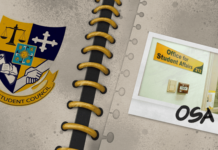
DESPITE the disruptions caused by the Covid-19 pandemic, UST’s Learning-Enhanced Accelerated Program for Medicine (LEAPMed) has delivered its intended learning outcomes, one of its developers said.
Prof. Larry King, a faculty member at the UST Faculty of Medicine and Surgery (FMS) who designed the framework of the program, told the Varsitarian that administering classes had been difficult, especially since some subjects were better delivered with face-to-face (F2F) laboratory work.
“Though we were able to deliver all the courses, nothing could match the F2F setup,” he said.
LEAPMed is a two-year full-blown preparatory course for medical studies introduced in Academic Year 2019-2020 aimed to lessen the burden on aspiring medical doctors.
When classes shifted to online in March 2020, students were hindered from using state-of-the-art facilities such as the Anatomage Table, a 3D visualization of the human anatomy, and virtual dissection tools.
“How did we overcome this one? In March and April, we allowed them to come to the school because we are already two years into the pandemic; the graduating batch, if we don’t allow them to come to school […] they would be graduating without seeing UST, it would be a pure, 100-percent online program for them,” King said.
Dr. Wenceslao Llauderes, an FMS faculty member, said the pandemic made teaching patient-care skills difficult, especially as “the essence of healing starts from a human touch.”
“[F]acilitators used personal experiences in their respective clinical practice relaying to students augmented by a live walk thru experience exposures in areas like emergency room, operating room and general wards,” he said.
“It’s a bit challenging because there was a major shift of teaching style from the F2F set up to virtual, but eventually we caught up with the new trend of time,” Llauderes said. “For me, the LEAPMed intended learning outcomes had been met.”
LEAPMed’s roots
The LEAPMed program was introduced after the implementation of the Enhanced Basic Education Law that added two years of high school to the basic education curriculum.
Without a direct bridging program, students who want to pursue medicine will have to study for 15 to 18 years – four to five years in a preparatory program, four years in medicine proper, one year in internship and five to seven years studying a specialization.
“[S]tudents are complaining that what they are taking right now are repetitions of most of the subjects in your Grade 11 and 12, so parang it is a waste of time and resources. So that’s why we came up with this innovative, shortened, intensive, preparatory course for medicine,” King said.
The two-year program consists of four regular terms with two special terms during the summer. Unlike other health-allied college programs with around 21 to 24 units per term, LEAPMed has 29 units for freshmen and 30 units for sophomores, while the special terms consist of nine units in year one and 12 in year two.
Llauderes said the curriculum of the program was more focused on the human sciences needed for medicine proper, which makes LEAPMed unique from other programs such as the University of the Philippines’ (UP) Integrated Liberal Arts and Medicine (IntarMed) program.
LEAPMed students are also allowed to use the facilities of the FMS as much as regular medical students do to give them more familiarity with medical equipment.
“In UP, it is handled by liberal arts, so there’s a major difference. So our students, they have an in-depth understanding already of the basic sciences and medicine because they are taken care of [by] members of the FMS,” King said.
From LEAPMed to med school
Maxine Francesco Baculo, a Batch 2021 LEAPMed graduate and a first-year medical student, said there were no “major differences” that would separate a LEAPMed and a non-LEAPMed student in medical school.
“Being a LEAPMed student enables you to be exposed to the ins and outs of medical school and the medical field in general. Because of this, medical concepts that would be essential in practice are taught very early on,” she said.
The same sentiment was shared by Mikaela Apollo, a summa cum laude graduate from Batch 2021, who said LEAPMed provided her with theoretical knowledge that helped her in medical school.
“Whatever subject we had in LEAPMed, it was reflected in med school,” she said. “It was a baby version of medicine, in a sense that they didn’t take out the important things. They emphasized the important things.”
Apollo said the program had given her as much “headstart” for medical school as it could despite the pandemic’s disruptions.
“LEAPMed really tried to give whatever it could to prepare us as much as it could for medicine,” she said. “It’s just a shame lang talaga na nagkaroon ng Covid kasi I think the curriculum is really nice and they really planned for it.”
Patricia Bojador, now in medicine proper, said that the formats of activities and examinations in LEAPMed gave her a glimpse of medical school.
“We can say that we got a ‘taste’ of what [med school] was like at that early age, and we were able to adjust our learning habits and manage our drives to achieve our goals,” she said.
Covid-19 has posed a steep challenge for LEAPMed’s pioneer batch, who experienced F2F classes for just nine months before moving on to medical school.
King, who also teaches physiology in UST’s medicine program, said LEAPMed graduates were notable in the FMS for getting high grades.
“I have also asked, communicated [other teachers], and they informed me that those getting high grades are mostly from LEAPMed,” he said.
Apollo said studying in a program as intensive as LEAPMed in a virtual setup was especially challenging.
“[S]a online, it’s so hard to try to find that motivation in itself. It wasn’t more of the quality. It was more of the work ethic kasi nawalan ako ng work ethic during that time. [‘Yung] burnout sa online was more enhanced or mas na-stress out siya,” she said.
Aside from being committed, LEAPMed students should also be determined and “have the stamina,” King added.
What’s next for LEAPMed?
As the present LEAPMed program caters to a select pool of 90 students, King floated the possibility of the program eventually increasing its number of slots.
“Since this is a new program, we limited it to two sections or 90 students. So, maybe in the future, if the direction is to go for a shortened preparatory course, then maybe we can offer LEAPMed. But, of course, I think LEAPMed is, sorry to say, not for everyone because it is a shortened intensive course,” he said.
King said the University was also aiming to gain accreditation from the Department of Science and Technology (DOST) so it could start offering scholarships for LEAPMed.
“We want the program to be accredited by DOST so that most of the students can avail of the scholarship provided by DOST. […] Our students are from all over the Philippines and many of them are financially challenged. So, we need funding. That would be a very good help for our students if we will be accredited by DOST,” he said.
















